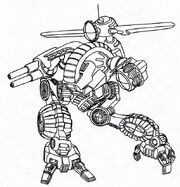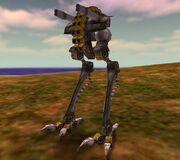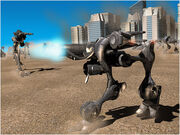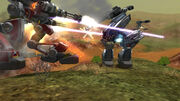
The Hunter Scout, a MAV in Dark Horizons Lore
Mechanized Assault Vehicles are large robot mechs, used as the main form of Military in the Dark Horizons Lore series of video games.
Design and Background[]

The Mantis
The mechs were designed as the mechs for Lore as it was developed to be a mech game. There were 2 types of mechs - 3 walkers and a tank, for 2 factions. The Federated States mechs were made in a blue color-scheme and more sleek in their design, than their Eastern Confederation counter parts which seemed more mechanic in their designs. Later, in the Invasion update, the Federated States mechs textures were redesigned to be more metallic in design. These mechs, other than the different primary weapon selections, weren't very customizable visually, though the player could select their weapons and edit their armor/speed ratio.
In Lore: Aftermath, the mechs were drastically changed in design, to be more like traditional mechs in other mech simulations. The mechs were also much more customizable, with different slots for over 25 different selectable weapons and equipment. The mech's chasis could also be edited visually, with a selection of colors and paint schemes. The player could also edit the mech's armor stats.
History[]
Creation of the Mechs[]
When the Federated States called for an effective way of defending No Man's Land from any potential attackers, Armatron Robotics answered in 2100, with their Mechanized Assault Vehicles, giant mechanized robots that could be remotely piloted from large distances, with the use of control pods which hold the pilot when he is linked to the mech.
The system worked better than expected; the pilots were able to control their mech with great skill. However, the system did have one drawback - when a mech was destroyed, the feedback sent through the External Interface Core Technology (EICT) implant would cause an incredible amount of pain, at times killing the pilot.
The mechs were produced in New Mexico and shipped to the borders of No Man’s Land. EICT equipped pilots of these massive machines would be stationed in FAF Army Central Command Centers around the Midwest. From there they could control the mech their pods.
Machine Wars[]

MAVs during the Machine Wars
In 2158, Eastern Confederation began preparations to launch an attack on No Man's Land; Technology of the mech systems was leaked to the Confederation's science teams, and were mass produced to create a series of Confederation's own mechs, which were linked to their pilots via satellite. After being defeated by the Federation in the battles for Finland, the Confederation decided to turn its attention to the United States, in a hope of catching the Federation off guard.
On May 1st, 2160, the Eastern Confederation Mechanized Army begin their invasion of the United States, attacking several mining operations along No Man's Land. The Federated States Mechanized Army send units in response. An 8 year long war, dubbed the "Machine War" begins.
Aftermath[]

MAVs in Aftermath
After the Machine Wars ended in 2168, the world fell into collapse. Order gave way to chaos and anarchy as the Eastern Confederation and Federated States collapsed in on themselves in exhaustion of resources, from constantly having to resupply destroyed mechs. The fatal flaw in the original mech design was the sense that the mech was a disposable weapon, causing trillions of credits to be spent on replacements as the cyber pilots felt little responsibility to keeping their mechs in one piece. Additionally, because of the small size of the original designs heavier payloads were not possible.
Feeding off both the successes of the weapons platform and learning from its failures the two leading manufacturers in the world of mechs, Cyber-TRONIX and Kalash-Bloc, began the production of a new generation of war machine. These new mech models range from 25 - 35 feet tall, weighing in from 40 to 75 tons just for the base chassis.
Another change from the original designs was allowing chassis classes to be more modular in design. Pilots are much more free to have their mech customized to their strengths. Even larger chassis' can be configured with a hint of quickness and ability to move, and for smaller chassis, the ability to carry larger payloads. The new designs required an on-board pilot, who, similar to his predecessor, would be jacked into his on-board computer. The obvious bigger difference is the return of the pilot onto the battlefield. In field testing not only did pilots acclimate faster to the controls of their machines, but response times and tenacity increase by several fold. mech pilots became highly revered for the mental and physical prowess that is required of them on the battlefield and in the arena.
Known mechs[]
| Lore / Invasion / Lore d20 |
|---|
|
| Aftermath |
|---|
|
| Unreleased / Unknown |
|---|
|
See Also[]
- MAV Lab
- Dark Horizons Lore (Series)




